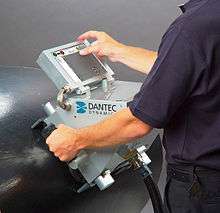Shearography
Shearography or Speckle pattern shearing interferometry is a measuring and testing method similar to holographic interferometry. It uses coherent light or coherent soundwaves[1] to provide information about the quality of different materials in nondestructive testing, strain measurement, and vibration analysis. Shearography is extensively used in production and development in aerospace,[2] wind rotor blades, automotive, and materials research areas.[3] Advantages of shearography are the large area testing capabilities (up to 1 m² per minute), non-contact properties, its relative insensitivity to environmental disturbances, and its good performance on honeycomb materials, which is a big challenge for traditional nondestructive testing methods.

Shearing function
When a surface area is illuminated with a highly coherent laser light, a stochastical interference pattern is created. This interference pattern is called a speckle, and is projected on a rigid camera's CCD chip. Analogous with Electronic speckle pattern interferometry (ESPI), to obtain results from the speckle we need to compare it with a known reference light. Shearography uses the test object itself as the known reference; it shears the image so a double image is created. The superposition of the two images, a shear image, represents the surface of the test object at this unloaded state. This makes the method much less sensitive to external vibrations and noise. By applying a small load, the material will deform. A nonuniform material quality will generate a nonuniform movement of the surface of the test object. A new shearing image is recorded at the loaded state and is compared with the sheared image before load. If a flaw is present, it will be seen.[4]
Phase-shift technology
To increase the sensitivity of the measurement method, a real-time phase shift process is used in the sensor. This contains a stepping mirror that shifts the reference beam, which is then processed with a best fit-algorithm and presents the information in real time.
Applications
The main applications are in composite nondestructive testing, where typical flaws are: Disbonds, Delaminations, Wrinkles, Porosity, Foreign objects, and Impact damages.
Industries where Shearography is used are: Aerospace, Space, Boats, Wind power, Automotive, Tires, and Art conservation.[5]
Inspection standards
The methodology of shearography is standardized by ASTM International:
- ASTM E2581-07, "Standard Practice for Shearography on Polymer Matrix Composites, Sandwich Core Materials and Filament Wound Pressure Vessel’s in Aerospace Applications"
The following NDT personnel certification documents contain references to shearography:
- BS EN 4179:2009
- NAS 410, 2008 Rev 3
- ASNT SNT-TC-1A, 2006 edition
- ASNT CP-105, 2006 edition
References
| Wikimedia Commons has media related to Shearography. |
- Ng, Jeanette. "Gadget holds key to safer buildings" The Standard September 1, 2005 Archived January 24, 2011, at WebCite
- Garfinkel, Simson L. "Laser Lights Up Flaws" Christian Science Monitor January 20, 1989, p.12
- Steinchen, Wolfgang and Lianxiang Yang. Digital Shearography: Theory and Application of Digital Speckle Pattern Shearing Interferometry SPIE Press: 1 January 2003 ISBN 978-0-8194-4110-2 Archived 24 January 2011 at WebCite
- Hung, YT. "Shearography: A new optical method for strain measurement and nondestructive testing". Optical Engineering. 21 (May/June 1982): 391–395.
- MK Meybodi, I Dobrev, P Klausmeyer, EJ Harrington, C Furlong, "Investigation of thermomechanical effects of lighting conditions on canvas paintings by laser shearography",SPIE Optical Engineering+ Applications, 2012